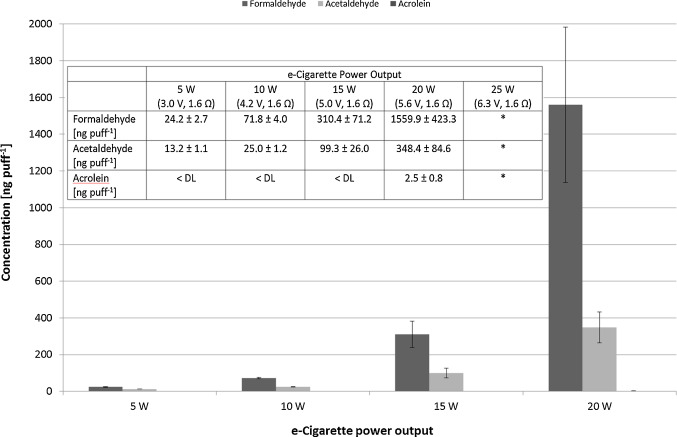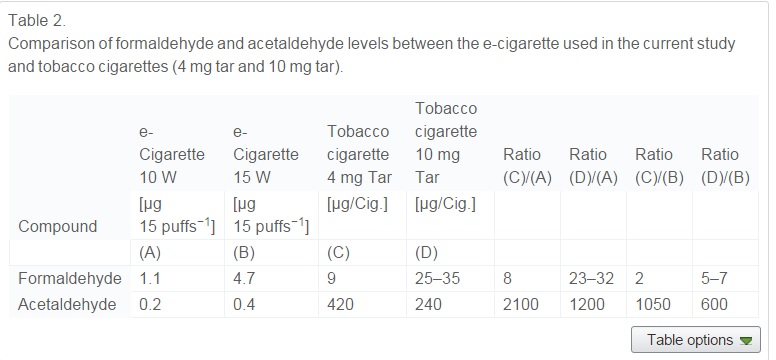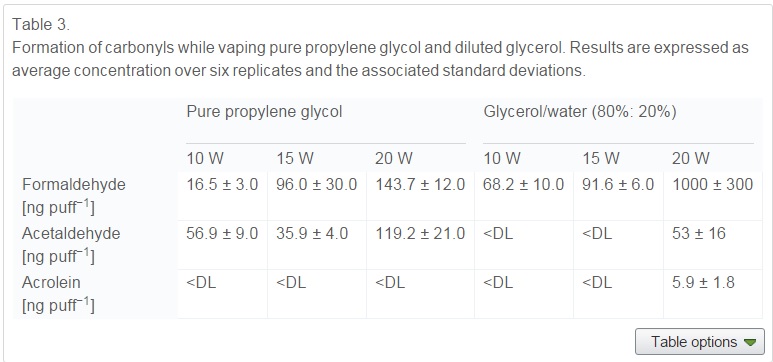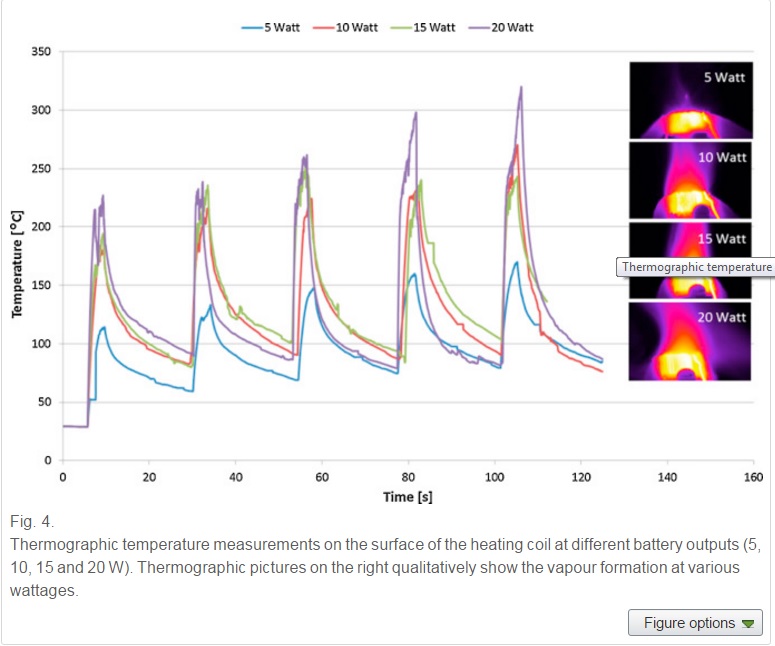The paper is titled:
"Correlation of volatile carbonyl yields emitted by e-cigarettes with the temperature of the heating coil and the perceived sensorial quality of the generated vapours" and was was published in the International Journal of Hygiene and Environmental Health. The full paper is available here.
For those who don't want to read it, I did, and I will summarize it below.
Goal:
The goal of this paper was to measure carbonyl formation at various wattages and coil temperatures. Carbonyls are basically "the bad stuff" us vapers hear about in the media. They include formaldehyde (and all the other aldehydes) as well as acrolein.
Equipment and Methodology:
They used a 1.6Ω nichrome 80 (11 wrap) build inside of a kayfun 3.1 with a cotton wick. The mod was an iStick 30. They fired it in a smoking machine, collected the vapor in something called a "DNPH-based trapping cartridge" and then put it through a chemical analysis using HPLC (High-Performance Liquid Chromatography). They measured the coil temp using a FLIR (model T450SC) camera set to 0.96 emissivity. The smoking regimen was 3 second puffs with a 20 second break in between puffs. The power levels they used were 5W, 10W, 15W, and 20W. They measured the carbonyl levels at each power level. They also had a human volunteer (an experienced vaper) sample the device at each power level and provide his/her satisfaction with the heat/flavor/vapor production so that they could avoid the problem of "No way in hell anyone would vape that." They used a commercial liquid with flavorings as well as 100% PG (no flavors or nic) and 80% VG/20% water mix (no flavors or nic). At the end, they took the chimney off the kayfun and direct dripped onto the wick so they could measure the coil temp at different power levels with the FLIR camera.
For the commercial liquid they used "Heaven juice 7 Leaves Tobacco" which is basically Flavourart's own house blend. For any DIY'ers, you probably are familiar with "7 Leaves" from Flavourart. This liquid was 50% VG, 40% PG, 6% water, 3% flavoring, 1% nicotine.
Results of the flavored liquid:

As you can see, the levels of carbonyls increased with an increase in power. The vaper they had on hand suggested that he/she was most comfortable and satisfied at between 10-15 watts, so the 20W value is most likely resulting in what a human would consider a "dry puff condition." These dry puff conditions have been the downfall of (most) previous papers on the topic of carbonyls in e-cigs. Also interesting to note is that acrolein was not detected at all until 20W. (The researchers also fired it at 25W but said the results were too scattered and inconsistent to be of use).
Compared to Smoking:
Another downfall of previous papers on the topic is the researchers often did not compare their findings to cigarette smoke (Dr. Farsilinos in particular has harped on this point). Or if they did compare it, they only compared "dry puff" conditions to cigarettes and tried to pass that off as "normal vaping." (See the highly flawed NEJM paper that caused a stir in the media with their claim that e-cigs produced 15 times the formaldehyde of smoking). These researchers set out to do this fairly and accurately, so comparing their findings with smoking was of interest. However, they were careful to only compare normal vaping conditions to cigarettes -- not dry puffs..
In their testing, they used two reference cigarettes for comparison: a 4 mg tar cigarette and a 10mg tar cigarette. The results are in the table below:

As you can see, the level of formaldehyde in the cigarettes was between 2 and 32 times higher than the e-cig (depending on whether the ecig was at 10 or 15 watts). The levels of acetaldehyde were massively lower in e-cigs -- between 600 and 2100 times lower.
What Do These Numbers Really Mean?
Comparing to cigarettes is one thing, but everyone knows smoking is terrible and is a pretty low bar for comparison. So, these researchers compared their numbers to various exposure limits set by various scientific panels.
For formaldehyde they compared it to ATSDR, 2007, NAS, 2007a and NAS, 2007b. This is a threshold that determines how much formaldehyde is permissible so that sensitive individuals (such as asthmatics) will not be affected. That number is 370 µg m^-3. If you do the conversion, then the e-cig at 10W equates to 1436 µg m^-3 and at 15w equates to 6208 µg m^-3. Therefore, the e-cig is above this threshold at all "normal vaping" ranges. The WHO recommends a maximum value of 100 µg m^-3 for indoor air, so again, the e-cig surpasses this number several fold.
For acetaldehyde they reference a study that suggests 300ppm can cause irritation and symptoms in asthmatics. They mention that the levels measured in each puff in their study are lower than this value by a factor of 20. They also compared it to a specific German indoor air threshold of 100 µg m^-3. The values in the e-cigs were about 2.5 times larger than that depending on the battery power applied. So, it really depends on which threshold guideline you want to compare it to.
Acrolein was only detected at 20W (a value people likely wont vape a 1.6 Ω Kayfun at). In either case, they compared it to the AEGL-1 value and found it is below that threshold.
They concluded:
100% PG vs. 100% VG
The researchers also tested just the carrier liquids with no flavors or nic to determine how much of the aldehyde formation was a result of pyrolysis of the PG or VG. The results are in the table below:

This tells us a few things:
1) Formaldehyde can form from using either 100% PG or 100% VG (with no flavors or nicotine).
2) Acetaldehyde only forms from PG (and not VG) at normal vaping temps (though can form from VG at high, unvapable temps).
3) Acrolein is only formed as a result of the presence of VG, but only forms at high unrealistic vaping temps.
4) Using flavors and nic seems to increase the aldehyde formation at a given power level (you can compare this chart with the above chart).
Coil temperatures:
To my understanding the researchers did not measure the coil temp during the above tests. What they did, instead, was to do a few separate runs with the chimney removed so that they could directly drip onto the wick. This is the only way an accurate measurement can be done with a FLIR camera. They drenched the wick and then took 5 puffs at each power level (without redripping) and measured the coil temp during each puff. What they found, of course, is that each successive puff was hotter than the previous.

As you can see from the chart, at 5w, the coil never went above about 170°C (~340°F). At 10W the coil was below 200°C (392°F) on the first puff and went to about 275°C (~527°F) by the 5th puff. At 15W the coil was at about 200°C (392°F) on the first puff and at about 250°C (~480°F) on the 5th puff. At 20W the coil was at about 225°C (~435°F) on the first puff and went to about 320°C (~600°F) on the 5th puff.
What they took from this is that at 10, 15 and 20W, the coil temperature did not change much during the first 3 puffs (on a saturated wick). It was only during the final two puffs (when the wick was drying out) that the 15 and 20W power settings began separating from one another in temperature. This confirms what basic physics has told us all all along -- as long as the wick is wet, it doesn't really matter at what power level one vapes. The coil temperature will stay near thermal equilibrium of the boiling liquid until there is less liquid to boil (in other words, the wick begins to dry out). However, keep in mind that a human may not always be able to detect this with mere taste alone (not until the temp goes way out of control). Therefore, it's very likely that each successive puff you take will produce more carbonyls until you redrip (or let your wick saturate in your tank).
My Takeaway From This Study
The correlation between temperature, dry wicks and carbonyls is why I think temp controlled devices are important and I applaud Evolv for being ahead of the game and introducing that idea to the market. With temp control (assuming it is calibrated properly), the coil will never go above a set temp. If it dries out, it will merely produce less vapor until the wick is resaturated. This will reduce (but probably not totally eliminate) our exposure to carbonyls.
In the future I would like to see this study repeated with a temp controlled device. I would also like to see more concrete data on which temperatures are the "safest." Of course, if vaping at 350°F were satisfying, everyone would do it. Unfortunately, you don't get much aerosol production at those temps. My experience is that anything below 400°F is far too mild (and produces little vapor). I typically stay between 430 and 450°F. I would like to know the relative safety of this compared to lower or higher temperatures.
My second takeaway from this study is that we are getting some aldehydes in our vape, even at normal (pleasant) temperatures. The researchers showed this by using a vaper to sample each setting. He/she was most comfortable at between 10 and 15 watts. As you can see from the charts, the aldehyde levels increased at each successive power level (with 5W being the lowest).
"Correlation of volatile carbonyl yields emitted by e-cigarettes with the temperature of the heating coil and the perceived sensorial quality of the generated vapours" and was was published in the International Journal of Hygiene and Environmental Health. The full paper is available here.
For those who don't want to read it, I did, and I will summarize it below.
Goal:
The goal of this paper was to measure carbonyl formation at various wattages and coil temperatures. Carbonyls are basically "the bad stuff" us vapers hear about in the media. They include formaldehyde (and all the other aldehydes) as well as acrolein.
Equipment and Methodology:
They used a 1.6Ω nichrome 80 (11 wrap) build inside of a kayfun 3.1 with a cotton wick. The mod was an iStick 30. They fired it in a smoking machine, collected the vapor in something called a "DNPH-based trapping cartridge" and then put it through a chemical analysis using HPLC (High-Performance Liquid Chromatography). They measured the coil temp using a FLIR (model T450SC) camera set to 0.96 emissivity. The smoking regimen was 3 second puffs with a 20 second break in between puffs. The power levels they used were 5W, 10W, 15W, and 20W. They measured the carbonyl levels at each power level. They also had a human volunteer (an experienced vaper) sample the device at each power level and provide his/her satisfaction with the heat/flavor/vapor production so that they could avoid the problem of "No way in hell anyone would vape that." They used a commercial liquid with flavorings as well as 100% PG (no flavors or nic) and 80% VG/20% water mix (no flavors or nic). At the end, they took the chimney off the kayfun and direct dripped onto the wick so they could measure the coil temp at different power levels with the FLIR camera.
For the commercial liquid they used "Heaven juice 7 Leaves Tobacco" which is basically Flavourart's own house blend. For any DIY'ers, you probably are familiar with "7 Leaves" from Flavourart. This liquid was 50% VG, 40% PG, 6% water, 3% flavoring, 1% nicotine.
Results of the flavored liquid:

As you can see, the levels of carbonyls increased with an increase in power. The vaper they had on hand suggested that he/she was most comfortable and satisfied at between 10-15 watts, so the 20W value is most likely resulting in what a human would consider a "dry puff condition." These dry puff conditions have been the downfall of (most) previous papers on the topic of carbonyls in e-cigs. Also interesting to note is that acrolein was not detected at all until 20W. (The researchers also fired it at 25W but said the results were too scattered and inconsistent to be of use).
Compared to Smoking:
Another downfall of previous papers on the topic is the researchers often did not compare their findings to cigarette smoke (Dr. Farsilinos in particular has harped on this point). Or if they did compare it, they only compared "dry puff" conditions to cigarettes and tried to pass that off as "normal vaping." (See the highly flawed NEJM paper that caused a stir in the media with their claim that e-cigs produced 15 times the formaldehyde of smoking). These researchers set out to do this fairly and accurately, so comparing their findings with smoking was of interest. However, they were careful to only compare normal vaping conditions to cigarettes -- not dry puffs..
In their testing, they used two reference cigarettes for comparison: a 4 mg tar cigarette and a 10mg tar cigarette. The results are in the table below:

As you can see, the level of formaldehyde in the cigarettes was between 2 and 32 times higher than the e-cig (depending on whether the ecig was at 10 or 15 watts). The levels of acetaldehyde were massively lower in e-cigs -- between 600 and 2100 times lower.
What Do These Numbers Really Mean?
Comparing to cigarettes is one thing, but everyone knows smoking is terrible and is a pretty low bar for comparison. So, these researchers compared their numbers to various exposure limits set by various scientific panels.
For formaldehyde they compared it to ATSDR, 2007, NAS, 2007a and NAS, 2007b. This is a threshold that determines how much formaldehyde is permissible so that sensitive individuals (such as asthmatics) will not be affected. That number is 370 µg m^-3. If you do the conversion, then the e-cig at 10W equates to 1436 µg m^-3 and at 15w equates to 6208 µg m^-3. Therefore, the e-cig is above this threshold at all "normal vaping" ranges. The WHO recommends a maximum value of 100 µg m^-3 for indoor air, so again, the e-cig surpasses this number several fold.
For acetaldehyde they reference a study that suggests 300ppm can cause irritation and symptoms in asthmatics. They mention that the levels measured in each puff in their study are lower than this value by a factor of 20. They also compared it to a specific German indoor air threshold of 100 µg m^-3. The values in the e-cigs were about 2.5 times larger than that depending on the battery power applied. So, it really depends on which threshold guideline you want to compare it to.
Acrolein was only detected at 20W (a value people likely wont vape a 1.6 Ω Kayfun at). In either case, they compared it to the AEGL-1 value and found it is below that threshold.
They concluded:
In conclusion, the short-term guideline concentration value for formaldehyde is already exceeded at the lowest wattage when considering the concentration in each inhaled puff. The opposite is true for acetaldehyde where the threshold values are not exceeded even at the highest battery wattage. Acrolein was detected only at a setting of 20 W: vaping conditions unlikely to be applied by vapers.
100% PG vs. 100% VG
The researchers also tested just the carrier liquids with no flavors or nic to determine how much of the aldehyde formation was a result of pyrolysis of the PG or VG. The results are in the table below:

This tells us a few things:
1) Formaldehyde can form from using either 100% PG or 100% VG (with no flavors or nicotine).
2) Acetaldehyde only forms from PG (and not VG) at normal vaping temps (though can form from VG at high, unvapable temps).
3) Acrolein is only formed as a result of the presence of VG, but only forms at high unrealistic vaping temps.
4) Using flavors and nic seems to increase the aldehyde formation at a given power level (you can compare this chart with the above chart).
Coil temperatures:
To my understanding the researchers did not measure the coil temp during the above tests. What they did, instead, was to do a few separate runs with the chimney removed so that they could directly drip onto the wick. This is the only way an accurate measurement can be done with a FLIR camera. They drenched the wick and then took 5 puffs at each power level (without redripping) and measured the coil temp during each puff. What they found, of course, is that each successive puff was hotter than the previous.

As you can see from the chart, at 5w, the coil never went above about 170°C (~340°F). At 10W the coil was below 200°C (392°F) on the first puff and went to about 275°C (~527°F) by the 5th puff. At 15W the coil was at about 200°C (392°F) on the first puff and at about 250°C (~480°F) on the 5th puff. At 20W the coil was at about 225°C (~435°F) on the first puff and went to about 320°C (~600°F) on the 5th puff.
What they took from this is that at 10, 15 and 20W, the coil temperature did not change much during the first 3 puffs (on a saturated wick). It was only during the final two puffs (when the wick was drying out) that the 15 and 20W power settings began separating from one another in temperature. This confirms what basic physics has told us all all along -- as long as the wick is wet, it doesn't really matter at what power level one vapes. The coil temperature will stay near thermal equilibrium of the boiling liquid until there is less liquid to boil (in other words, the wick begins to dry out). However, keep in mind that a human may not always be able to detect this with mere taste alone (not until the temp goes way out of control). Therefore, it's very likely that each successive puff you take will produce more carbonyls until you redrip (or let your wick saturate in your tank).
My Takeaway From This Study
The correlation between temperature, dry wicks and carbonyls is why I think temp controlled devices are important and I applaud Evolv for being ahead of the game and introducing that idea to the market. With temp control (assuming it is calibrated properly), the coil will never go above a set temp. If it dries out, it will merely produce less vapor until the wick is resaturated. This will reduce (but probably not totally eliminate) our exposure to carbonyls.
In the future I would like to see this study repeated with a temp controlled device. I would also like to see more concrete data on which temperatures are the "safest." Of course, if vaping at 350°F were satisfying, everyone would do it. Unfortunately, you don't get much aerosol production at those temps. My experience is that anything below 400°F is far too mild (and produces little vapor). I typically stay between 430 and 450°F. I would like to know the relative safety of this compared to lower or higher temperatures.
My second takeaway from this study is that we are getting some aldehydes in our vape, even at normal (pleasant) temperatures. The researchers showed this by using a vaper to sample each setting. He/she was most comfortable at between 10 and 15 watts. As you can see from the charts, the aldehyde levels increased at each successive power level (with 5W being the lowest).
Last edited:
